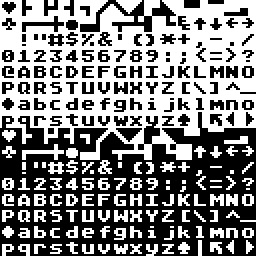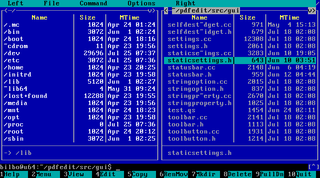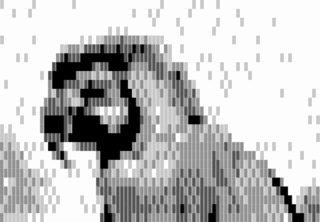
The Apple II series is a family of home computers, one of the first highly successful mass-produced microcomputer products, designed primarily by Steve Wozniak, manufactured by Apple Computer, and launched in 1977 with the original Apple II.

The Apple IIe is the third model in the Apple II series of personal computers produced by Apple Computer. The e in the name stands for enhanced, referring to the fact that several popular features were now built-in that were formerly only available as upgrades or add-ons in earlier models. It is notable as the first Apple II to offer built-in lower-case and 80 columns text support, as well a full 64K RAM–all while reducing the total chip count from previous models by approximately 75%.

The Apple IIe Card is a hardware emulation board, also referred to as compatibility card, which allows compatible Macintosh computers to run software designed for the Apple II series of computers. Released in March 1991 for use with the LC family, Apple targeted the card at its widely dominated educational market to ease the transition from Apple II-based classrooms, with thousands of entrenched educational software titles, to Macintosh-based classrooms.

The Apple IIGS is a 16-bit personal computer produced by Apple Computer. It is the fifth and most powerful of the Apple II family. It is compatible with earlier Apple II models but has a Macintosh look and feel, and resolution and color similar to the Amiga and Atari ST. The "GS" in the name stands for "Graphics and Sound", referring to its enhanced multimedia hardware, especially its state-of-the-art audio.

The Apple IIc, the fourth model in the Apple II series of personal computers, is Apple Computer's first endeavor to produce a portable computer. The result was a 7.5 lb (3.4 kg) notebook-sized version of the Apple II that could be transported from place to place — a portable alternative and complement to the Apple IIe. The c in the name stood for compact, referring to the fact it was essentially a complete Apple II computer setup squeezed into a small notebook-sized housing. While sporting a built-in floppy drive and new rear peripheral expansion ports integrated onto the main logic board, it lacks the internal expansion slots and direct motherboard access of earlier Apple II models, making it a closed system like the Macintosh. However, that was the intended direction for this model — a more appliance-like machine, ready to use out of the box, requiring no technical know-how or experience to hook up and therefore attractive to first-time users.

The ATASCII character set, from ATARI Standard Code for Information Interchange, alternatively ATARI ASCII, is the variation on ASCII used in the Atari 8-bit family of home computers. The first of this family are the Atari 400 and 800, released in 1979, and later models were released throughout the 1980s. The last computer to use the ATASCII character set is the Atari XEGS which was released in 1987 and discontinued in 1992. The Atari ST family of computers use the different Atari ST character set.

Michael Everson is an American and Irish linguist, script encoder, typesetter, type designer and publisher. He runs a publishing company called Evertype, through which he has published over a hundred books since 2006.
The ConScript Unicode Registry is a volunteer project to coordinate the assignment of code points in the Unicode Private Use Areas (PUA) for the encoding of artificial scripts, such as those for constructed languages. It was founded by John Cowan and was maintained by him and Michael Everson. It is not affiliated with the Unicode Consortium.

Apple Inc. uses a large variety of typefaces in its marketing, operating systems, and industrial design with each product cycle. These change throughout the years with Apple's change of style in their products. This is evident in the design and marketing of the company.
Miscellaneous Symbols is a Unicode block (U+2600–U+26FF) containing glyphs representing concepts from a variety of categories: astrological, astronomical, chess, dice, musical notation, political symbols, recycling, religious symbols, trigrams, warning signs, and weather, among others.
The Command key, ⌘, formerly also known as the Apple key or open Apple key, is a modifier key present on Apple keyboards. The Command key's purpose is to allow the user to enter keyboard commands in applications and in the system. An "extended" Macintosh keyboard—the most common type—has two command keys, one on each side of the space bar; some compact keyboards have one only on the left.

Box-drawing characters, also known as line-drawing characters, are a form of semigraphics widely used in text user interfaces to draw various geometric frames and boxes. These characters are characterised by being designed to be connected horizontally and/or vertically with adjacent characters, which requires proper alignment. Box-drawing characters therefore typically only work well with monospaced fonts. In graphical user interfaces, these characters are much less useful as it is more simple and appropriate to draw lines and rectangles directly with graphical APIs. However, they are still useful for command-line interfaces and plaintext comments within source code.
The Mega II is a custom chip from Apple Computer that is essentially an entire Apple II computer-on-a-chip. At least three products from Apple made use of the chip between 1986 and 1995. It was most predominantly used in the Apple IIGS microcomputer, and the basis for a modified variant, called the "Gemini" chip, which was later used in the Apple IIe Card for the Macintosh LC. This custom application-specific integrated circuit (ASIC) integrated most of the circuitry from earlier Apple II models onto one 84-pin PLCC integrated circuit, drastically simplifying design and cost for Apple. The Mega II contained the functional equivalent of an entire Apple IIe computer, which, combined with the 65C02 emulation mode of the 65C816 processor, plus ROM and RAM, provided full support for legacy (8-bit) Apple II software in the Apple IIGS. The result was one of the earliest single chip examples of full system hardware emulation.

The Unicode Consortium and the ISO/IEC JTC 1/SC 2/WG 2 jointly collaborate on the list of the characters in the Universal Coded Character Set. The Universal Coded Character Set, most commonly called the Universal Character Set, is an international standard to map characters, discrete symbols used in natural language, mathematics, music, and other domains, to unique machine-readable data values. By creating this mapping, the UCS enables computer software vendors to interoperate, and transmit—interchange—UCS-encoded text strings from one to another. Because it is a universal map, it can be used to represent multiple languages at the same time. This avoids the confusion of using multiple legacy character encodings, which can result in the same sequence of codes having multiple interpretations depending on the character encoding in use, resulting in mojibake if the wrong one is chosen.

Apple Inc. has designed and manufactured several models of mice, trackpads and other pointing devices, primarily for use with Macintosh computers. Over the years, Apple has maintained a distinct form and function with its mice that reflect their design languages of that time. Apple's current external pointing devices are the Magic Mouse 2 and Magic Trackpad 2.

Text-based semigraphics, pseudographics, or character graphics is a primitive method used in early text mode video hardware to emulate raster graphics without having to implement the logic for such a display mode.

The Atari ST character set is the character set of the Atari ST personal computer family including the Atari STE, TT and Falcon. It is based on code page 437, the original character set of the IBM PC, and like that set includes ASCII codes 32–126, extended codes for accented letters (diacritics), and other symbols. It differs from code page 437 in using other dingbats at code points 0–31, in exchanging the box-drawing characters 176–223 for the Hebrew alphabet and other symbols, and exchanging code points 158, 236 and 254–255 with the symbols for sharp S, line integral, cubed and macron.
The TRS-80 computer manufacturered by Tandy / Radio Shack contains an 8-bit character set. It is partially derived from ASCII, and shares the code points from 32 - 95 on the standard model. Code points 96 - 127 are supported on models that have been fitted with a lower-case upgrade.
This article covers technical details of the character encoding system defined by ETS 300 706, a standard for World System Teletext, and used for the Viewdata and Teletext variants of Videotex in Europe.
Symbols for Legacy Computing is a Unicode block containing graphic characters that were used for various home computers from the 1970s and 1980s and in Teletext broadcasting standards. It includes characters from the Amstrad CPC, MSX, Mattel Aquarius, RISC OS, MouseText, Atari ST, TRS-80 Color Computer, Oric, Texas Instruments TI-99/4A, TRS-80, Minitel, Teletext, ATASCII, PETSCII, ZX80, and ZX81 character sets, as well as semigraphics characters.














